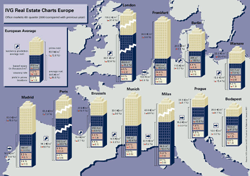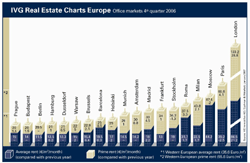IVG Immobilien: "Real Estate Barometer - European Office Markets 4th Quarter 2006"
IVG, la grande immobiliare quotata tedesca, ha diffuso in data 8 febbraio il proprio "Real Estate Barometer.European Office Markets Fourth Quarter 2006"
Ecco la sintesi:
«The volume let in the fourth quarter of 2006 on the major European office markets once again increased by an extraordinary degree. Strong demand for rental space supports the investment market, which continues to be characterised by an excess of demand over supply for good properties and thus falling yields. That is the core message for 2006 of the Real Estate Barometer published quarterly by IVG Immobilien AG and Cushman & Wakefield. "11.6 million square metres of office space was let in the previous year in the 22 major European cities investigated", said Bernd Kottmann, member of the Board of Directors for finances and portfolio management at IVG. The fourth quarter especially contributed to this with a share of 3.7 million square metres (an increase of 27.3% compared with the same quarter of 2005).
In the 18 West European locations investigated, space turnover increased by 16.6% compared with 2005 to 9.4 million square metres. 2.2 million square metres were let in the four Central and Eastern European cities. Not including Moscow, the Russian capital was not yet listed in the IVG Real Estate Barometer in 2005, growth in Budapest, Prague and Warsaw was 16.1%. The office market with by far the most turnover in 2006 was Paris. "With a volume let of 2.6 million square metres and an increase of 29.2%, the capital underlines its special position", stressed Kottmann. Moscow follows with 1.3 million square metres and London has just over 1 million square metres (an increase of 33.1%). Then come Munich and Madrid, each with around 660,000 square metres, and Brussels with 608,000 square metres let.
With an increase of almost 69%, growth in terms of space turnover is growing fastest in Stockholm, followed by Amsterdam with around 60% and Prague with over 50%. The German cities also showed an increase: Berlin by 21.5%, Düsseldorf by 19.2%, Hamburg by 14.2%, Munich by 12.7% and Frankfurt by 8.7%. In 2006, sharp declines were experienced only by Rome, by 30.7% to 76,600 square metres, and Brussels by 9.6%.
"In terms of vacancy rates, the German cities still come off the worst", regrets Bernd Kottmann. Across Europe, the vacancy rate is highest in Frankfurt at 16.6%, while in second place lies Düsseldorf at 11.6%. Berlin (9.3%), Munich (9.4%) and Hamburg (7.7%) are also above the European average of 7.15%.
Moscow has the lowest vacancy rate at 3.4%. However, new building activity has accelerated so rapidly that, according to Jones Lang LaSalle, the amount of space will increase by around 25% by the end of 2008. Kottmann therefore expects vacancy rates to rise. Furthermore, Barcelona, Madrid, Vienna and Warsaw have a vacancy rate of only 5.3% to 5.4%.
The sharpest drop in the vacancy rate in 2006 was seen in Amsterdam and Prague: by 5 percentage points in each case. In Stockholm, it fell by 4.6 percentage points. According the IVG Real Estate Barometer, the vacancy rate rose only in Budapest, by 1.2 percentage points. Across Europe, the vacancy rate fell in 2006 by 1.2 percentage points, a figure not recorded by any of the German cities investigated. In Munich, the vacancy rate fell at least by 1.1 percentage points, in Berlin, Düsseldorf and Hamburg it was only 0.3 percentage points and in Frankfurt it was 0.6 percentage points.
At EUR 133.20 per square meter, the prime rent in London is by far the highest, while Paris is in second place with EUR 60.80. Prime rents of over EUR 40 are being achieved in Moscow (EUR 47.40), Milan (EUR 43.75) and Zurich (EUR 41.40). The most reasonable locations are Vienna (EUR 19), Budapest, Prague and Lisbon (EUR 20). Furthermore, the German city of Berlin has a prime rent of EUR 20.50, while Düsseldorf and Hamburg both have prime rents of EUR 21; only Frankfurt, with EUR 34, belongs to the European middle ground. "Germany is still back in the Europe-wide recovery process, that is clear in this respect also, but for an anticyclical investment this can represent a major opportunity", judged Kottmann.
The greatest increase in the prime rents was recorded by Warsaw with 29.4%, followed by London with 27.6% and Madrid with 15.8%. Declines were recorded only in Moscow with 4% and Stockholm with 3.7%. "The fall in the prime rent in Moscow can be attributed, as with the increased vacancy rate, to the high completion figures", analysed Bernd Kottmann.
It is also interesting to look at the average rents. In London, at EUR 86.50 (an increase of 32.6% in 2006 alone), it is higher than the prime rent in Paris, the second most expensive location. The average rent paid in the French capital is EUR 39.20, which is more than in Rome (EUR 31.70), but much less than in Moscow (EUR 44.20). The best value is provided by average office in Berlin of EUR 11.50 and Vienna of EUR 12. Only a little more has to be paid in Düsseldorf (EUR 12.25) and Hamburg (EUR 12.50).
In only one city, Lisbon, of the 21 investigated Western and Central European locations, is there at least a 6% yield for a first-class office property. Three years ago, it was still possible to achieve yields of 6% or considerably more in 15 locations. The only exception returning a higher yield, Moscow with 8.25%, is currently in the IVG Real Estate Barometer.
The lowest yield being returned by first-class properties is 3.5% in Madrid. In London, 4% can be achieved, in Barcelona and Paris 4.25%. Investments in Stockholm are calculated on the basis of 4.5%, in Frankfurt, Milan and Munich on the basis of 4.75%. With minus 3.75 percentage points within the space of a year, the yields in Moscow fell the sharpest, followed by Warsaw with 1.25 percentage points. None of the markets investigated recorded an increase, only in Vienna did the yield remain stable at 5% over the year.
For average office properties, the yield in Lisbon was the highest at 7.5% (no figure is available for Moscow), followed by Helsinki with 7.2% and Budapest with 7%. The lowest yield received by investors in this segment is in Madrid with 5% and in Barcelona with 5.25%, as well as in London and Paris with 5.5% each» (CS della Società).

